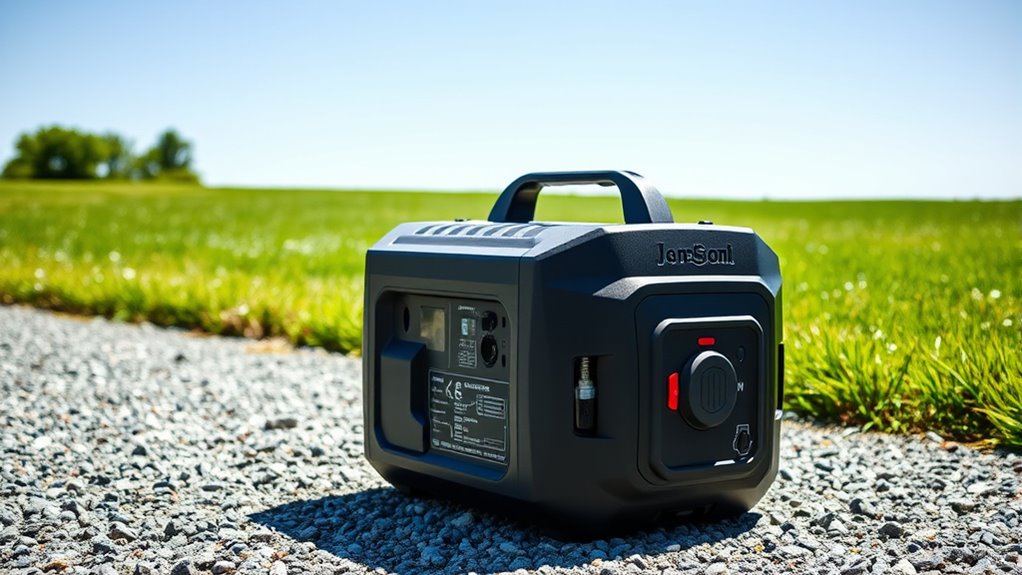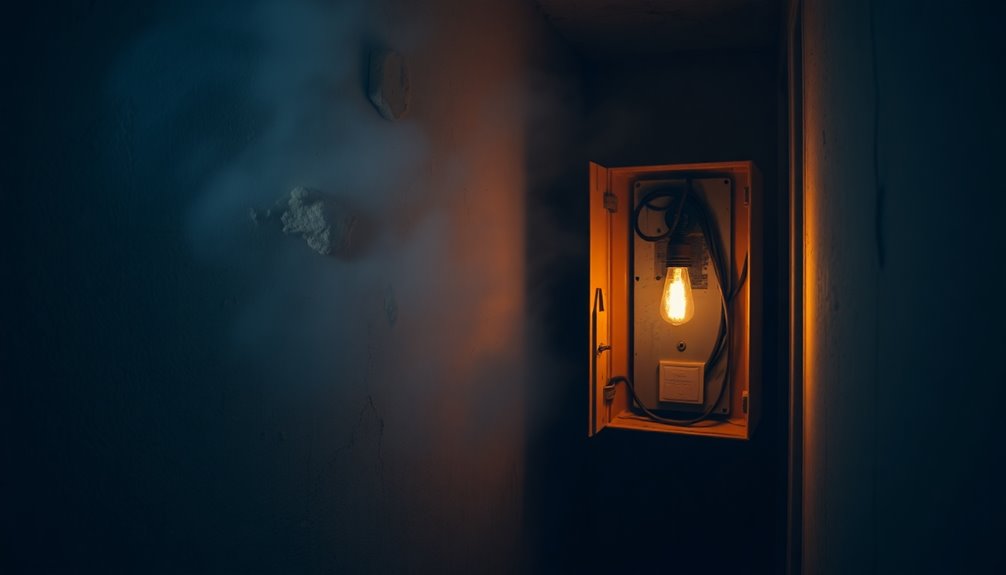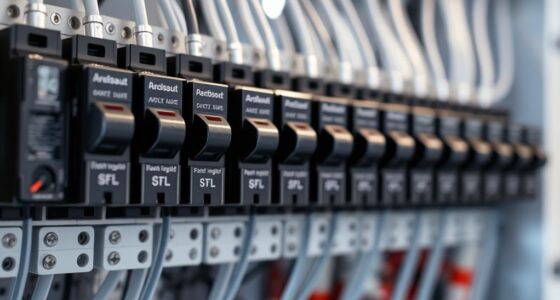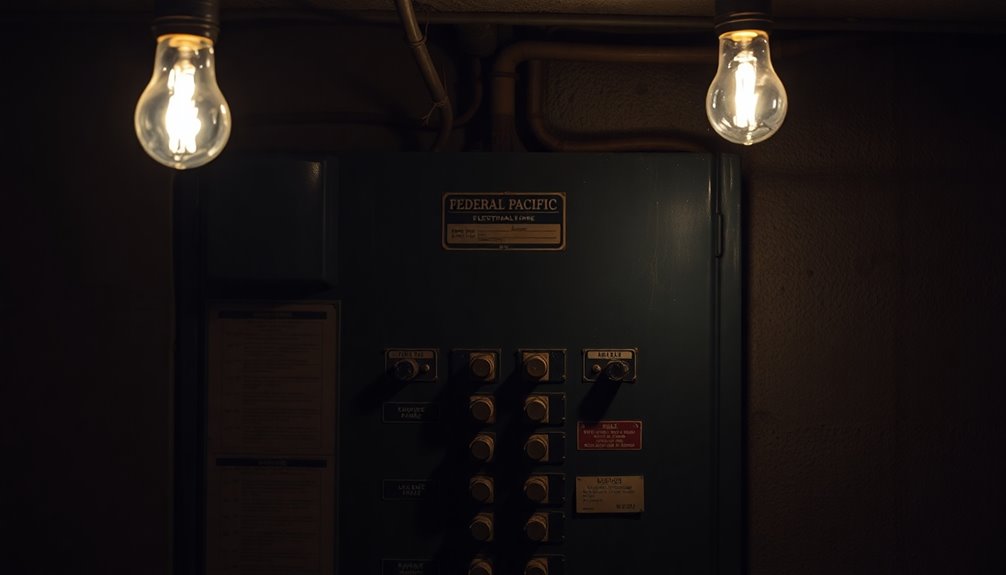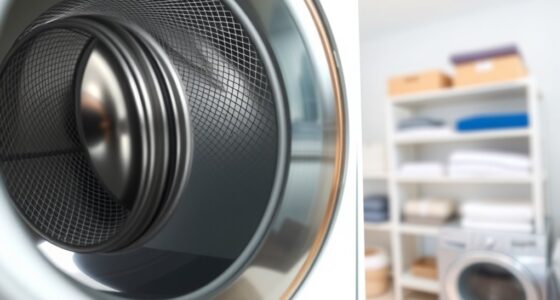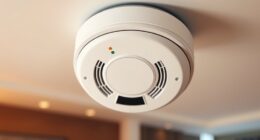To stay safe with portable generators indoors and out, always operate them outdoors in well-ventilated areas, at least 20 feet from your home and vents, to prevent deadly carbon monoxide buildup. Never run them inside garages, sheds, or enclosed spaces. Use heavy-duty extension cords for outdoor appliances, keep the area clear of obstructions, and perform regular maintenance. If you want to learn more about keeping yourself and your family safe, keep going for important tips and precautions.
Key Takeaways
- Always operate portable generators outdoors, at least 20 feet away from windows, doors, and vents to prevent carbon monoxide buildup.
- Never run generators inside enclosed spaces like garages or basements, even with open doors or windows.
- Place generators on flat, stable surfaces in well-ventilated areas, ensuring airflow is unobstructed and protected from rain or snow.
- Use proper extension cords rated for outdoor use, and keep the generator dry and protected from moisture.
- Regularly inspect and maintain your generator, including checking for leaks, proper grounding, and ensuring CO detectors are functioning.
Understanding the Risks of Portable Generators
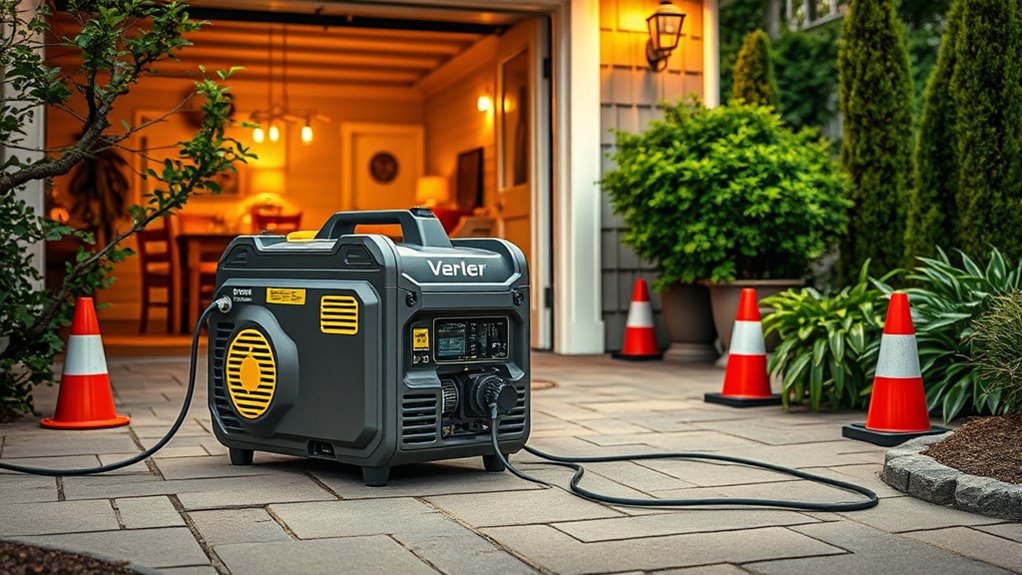
Portable generators are valuable during power outages, but they come with significant safety risks that you need to understand. One major danger is carbon monoxide poisoning. Running a generator indoors or in enclosed spaces produces deadly fumes that can quickly fill the area, risking death or severe health issues. Fire is another risk; improper handling of fuel or electrical faults can lead to fires or explosions. Also, electric shock hazards are common if you mishandle cords or overload circuits. You must be aware of these dangers to prevent accidents. Never run a generator inside, and always keep it outdoors in a well-ventilated area. Understanding these risks helps you operate your generator safely and avoid potentially life-threatening situations. Additionally, best anime movies can offer a relaxing way to unwind after dealing with emergencies.
Proper Placement and Ventilation Practices
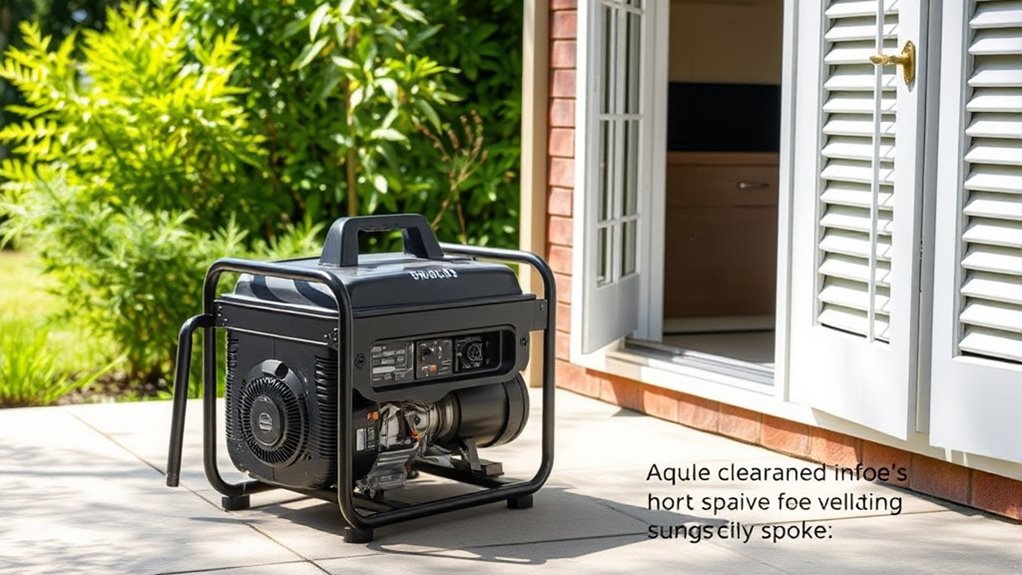
To stay safe, always place your generator in a well-ventilated outdoor area with plenty of space around it. Keep it away from enclosed spaces like garages or sheds to prevent dangerous fumes from building up. Proper placement and ventilation are key to avoiding carbon monoxide poisoning and other hazards. Additionally, regularly inspecting your generator for any functionality issues can help prevent unexpected failures that might compromise safety.
Clear Ventilation Space
Ensuring proper placement and ventilation is essential for safe generator operation. You need to keep your generator in a well-ventilated area, with enough space around it to prevent exhaust buildup. This reduces the risk of harmful carbon monoxide entering your home or workspace. Make sure there’s a clear, unobstructed path for airflow. Never block vents or exhaust outlets, and avoid placing the generator near windows or doors. Regularly check that airflow isn’t restricted by nearby objects or debris. Proper spacing not only improves safety but also helps your generator run efficiently. Keep these points in mind:
- Maintain at least 3 feet of clearance around the generator
- Avoid placing it near vents, windows, or doors
- Clear away leaves, dirt, or debris from ventilation areas
- Do not cover the exhaust outlet
- Ensure the area remains free of obstructions for ideal airflow
- Be aware that ventilation requirements are crucial to prevent dangerous buildup of exhaust gases.
Keep Generator Outdoors
Placing your generator outdoors is essential for safe operation, as it prevents dangerous buildup of carbon monoxide inside enclosed spaces. Always position your generator on a flat, stable surface away from windows, doors, and vents to prevent exhaust fumes from entering your home. Keep it at least 20 feet from your house, ensuring the exhaust is directed away from living areas. Avoid placing it in garages, sheds, or any enclosed structures, even if doors are open. Ensure there’s plenty of space around the generator for proper ventilation and airflow. Do not operate it in damp or wet conditions to reduce the risk of electrical shock. Proper placement minimizes health hazards and keeps your generator functioning efficiently, making safety your top priority. Additionally, understanding the importance of effective ventilation can significantly reduce the risk of carbon monoxide poisoning during operation.
Avoid Enclosed Areas
Avoid enclosing your generator in small, confined spaces, as this considerably increases the risk of dangerous carbon monoxide buildup. Proper placement guarantees good ventilation, reducing health hazards. Never operate your generator inside garages, sheds, or basements, even if doors are open. Instead, keep it outdoors, away from windows and vents. To improve safety, consider these tips:
- Place the generator on a dry, flat surface
- Maintain at least 20 feet distance from your home
- Shield it from rain and snow without blocking airflow
- Use extension cords to reach desired locations
- Ensure exhaust fumes can disperse freely into the air
Following these practices minimizes the risk of carbon monoxide poisoning and keeps your family safe during power outages.
Safe Operation During Power Outages and Outdoor Use

When operating a portable generator during power outages or outdoor activities, safety should be your top priority. Always set up your generator outdoors in a well-ventilated area, away from windows and doors. Use heavy-duty extension cords rated for outdoor use to connect appliances. Never operate the generator inside, including garages or sheds, to prevent fumes from entering enclosed spaces. To help you stay safe, consider this essential info:
| Safety Step | Key Point | Why It Matters |
|---|---|---|
| Location | Keep generator outside and away from structures | Prevents buildup of dangerous fumes |
| Grounding | Properly ground your generator | Avoids electrical shocks |
| Load Management | Don’t overload the generator | Ensures safe, reliable operation |
Additionally, understanding the AI developments in health and physics can influence future safety and technology standards.
Preventing Carbon Monoxide Poisoning
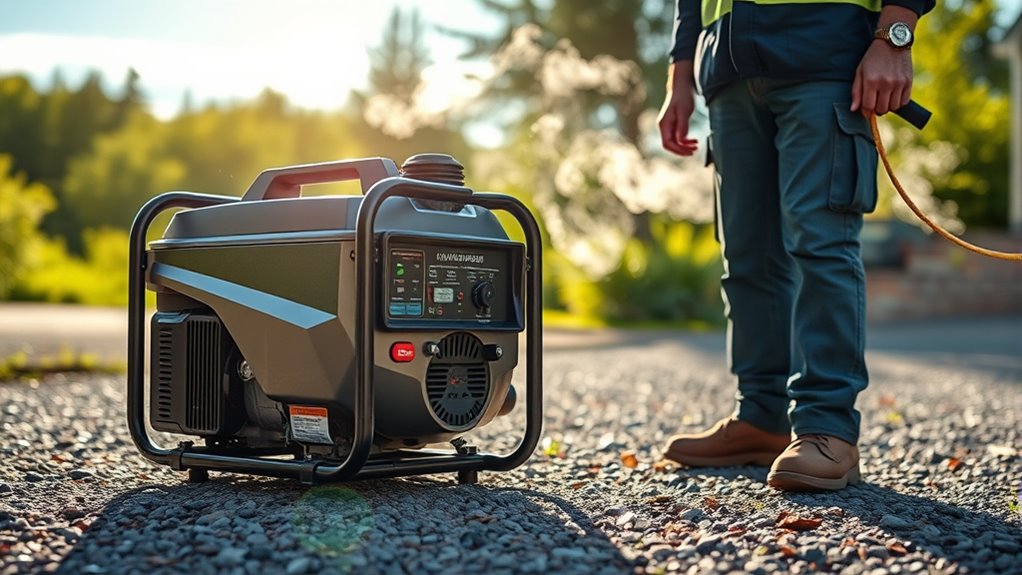
Since carbon monoxide (CO) is a colorless, odorless gas that can quickly cause poisoning, it’s essential to prevent its buildup around your generator. Always operate your generator outside, at least 20 feet away from windows, vents, and doors. Never run it indoors or in enclosed spaces, including garages, basements, or sheds. Keep the exhaust pipe clear of debris to avoid blockages. Use a CO detector near your living areas to alert you of dangerous levels. Regularly inspect your generator for leaks or damage. Remember, even a small amount of CO can be deadly, so prioritize ventilation and proper placement. Stay alert, and follow these safety tips to protect yourself and your loved ones from carbon monoxide poisoning. Implementing automation technologies can also help monitor safety devices and ensure proper operation.
Electrical Safety Tips and Grounding Procedures

Proper electrical safety and grounding are essential to prevent accidents and equipment damage when using a portable generator. Always operate the generator outdoors in a dry, well-ventilated area to avoid electrical shock. Use sturdy, outdoor-rated extension cords with grounded outlets, and never overload the generator beyond its capacity. Before connecting appliances, ensure your generator is properly grounded by following the manufacturer’s instructions—this minimizes the risk of electrical shock and fire. Keep all connections dry and inspect cords for damage regularly. When plugging in appliances, avoid daisy-chaining multiple extension cords or adapters, which can cause overheating. Remember, grounding and proper wiring are vital to protect yourself, your equipment, and your property from electrical hazards during generator use. Additionally, understanding power consumption insights can help you avoid overloading your generator and ensure safe operation.
Maintenance and Storage for Safe Usage
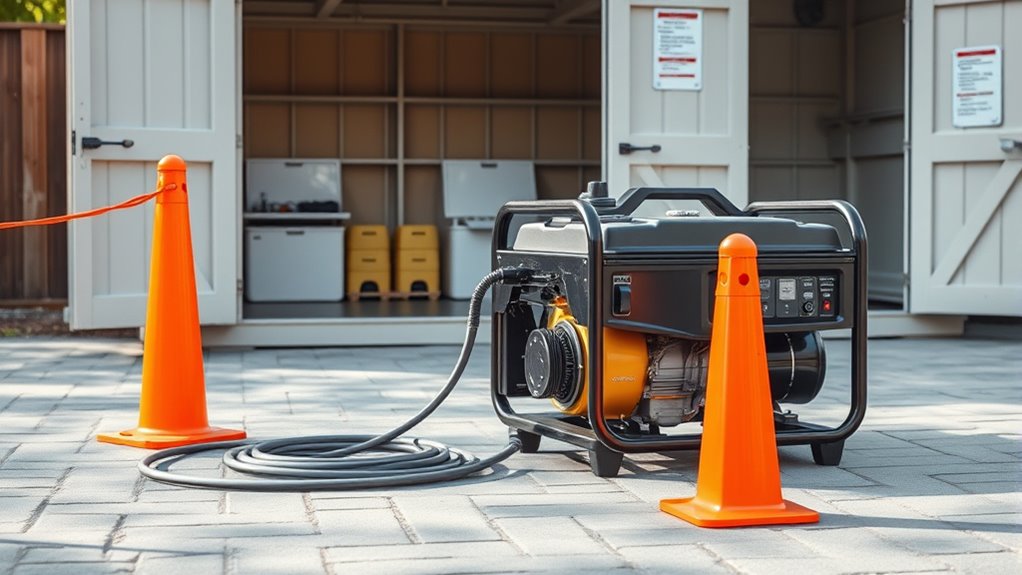
Keeping your generator well-maintained is key to safe operation. You should perform regular checks and follow the manufacturer’s guidelines to guarantee it runs smoothly. Proper storage also prevents damage and keeps your generator ready whenever you need it. Additionally, ensuring that the generator is kept in a well-ventilated area can help prevent buildup of dangerous fumes and improve overall safety air purifier maintenance.
Regular Maintenance Checks
Regular maintenance checks are essential to guarantee your portable generator operates safely and efficiently. By inspecting your generator regularly, you prevent potential hazards and ensure it performs when you need it most. Make it a habit to review key components and address issues early. Proper maintenance includes checking oil levels and changing oil according to the manufacturer’s schedule. Inspect spark plugs for wear or damage and replace if necessary. Clean or replace air filters to ensure proper airflow. Examine fuel lines for cracks or leaks. Test the automatic shutoff features and circuit breakers. Performing these simple checks regularly helps avoid unexpected breakdowns and reduces safety risks. Staying proactive with maintenance keeps your generator reliable, safe, and ready to power your essentials during emergencies or outdoor activities.
Proper Storage Practices
Storing your portable generator correctly is essential for maintaining its safety and longevity. After use, let it cool, then drain any fuel or add a fuel stabilizer if storing for a long period. Store the generator in a dry, well-ventilated area, away from living spaces. Keep it covered with a protective, non-flammable cover to prevent dust, dirt, and moisture buildup. Ensure the storage spot is secure and out of reach of children and pets. Regularly check for signs of corrosion or damage, and address issues promptly. Disconnect batteries if applicable, and keep fuel containers tightly sealed. Proper storage not only prolongs your generator’s lifespan but also reduces the risk of fire or other hazards during periods of inactivity. Consulting storage best practices can help you optimize your setup and ensure safety.
Frequently Asked Questions
Can Portable Generators Be Safely Used in Rain or Snow?
Using a portable generator in rain or snow isn’t safe because moisture can cause electrical shock or damage. You shouldn’t operate it outdoors in wet weather unless it’s properly protected in a waterproof, vented enclosure. Always keep the generator dry and away from standing water. If you must use it outside, use outdoor-rated extension cords, and ensure the generator is on a dry, stable surface. Safety first!
What Type of Fuel Is Safest for Indoor Generator Use?
When choosing a fuel for indoor generator use, you should prioritize safety and proper ventilation. Gasoline is common but highly flammable and produces dangerous fumes, so it’s not ideal indoors. Propane or natural gas are safer options because they burn cleaner and are less likely to cause carbon monoxide buildup. Always guarantee your space is well-ventilated, follow manufacturer guidelines, and never use fuels that aren’t recommended for indoor use.
Are There Specific Noise Level Regulations for Indoor Generator Operation?
Imagine a quiet library where silence is golden—this is what noise regulations aim for. You should check local laws because many areas set maximum decibel levels for generators, often around 60-70 dB. Keep in mind, indoor operation typically requires quieter models or soundproofing. Always adhere to these standards to avoid disturbing neighbors or facing fines, ensuring your generator’s roar stays within the peaceful library’s hush.
How Often Should a Portable Generator Be Inspected for Safety?
You should inspect your portable generator regularly to guarantee safety. It’s best to check it before each use and perform a thorough inspection at least once a month. Look for signs of wear, leaks, or damage, and ensure all parts are functioning properly. Regular inspections help prevent accidents, improve performance, and extend the generator’s lifespan. Always follow the manufacturer’s guidelines for maintenance and safety checks.
What Are the Signs of Carbon Monoxide Poisoning to Watch For?
Imagine feeling so dizzy, your vision blurs like a watercolor painting, or experiencing sudden nausea that hits you like a freight train. These are signs of carbon monoxide poisoning you must watch for. You might also feel weak, confused, or have a headache that feels like a drum pounding inside your skull. If these symptoms appear, get fresh air immediately and seek emergency medical help—your life could depend on it.
Conclusion
By following these safety tips, you’ll keep your home and loved ones protected, turning a potential disaster into a well-controlled storm. Imagine your generator as a trusted guardian, standing vigilant against danger, but only if you respect its power and treat it with care. Stay alert, stay safe, and let responsible use be the guiding light that keeps your family secure and your life running smoothly, no matter where you’re using your generator.
